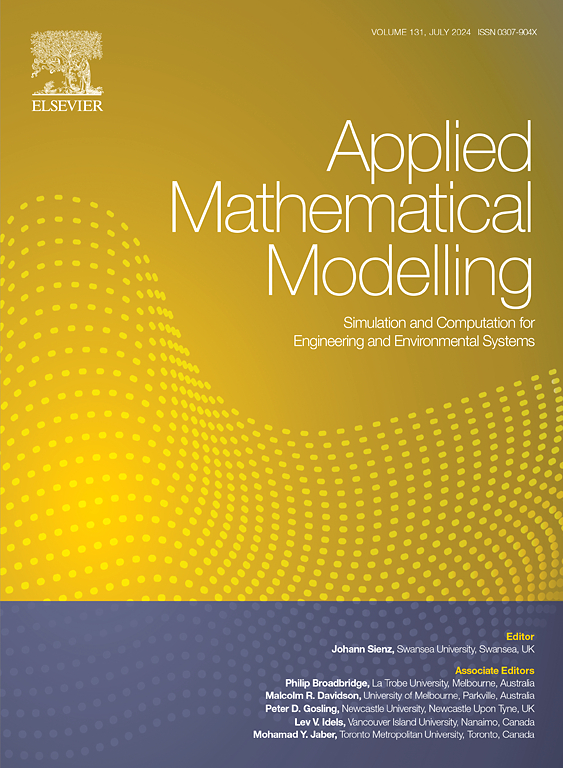Research on basin ecological compensation in the Yangtze River Economic Belt based on the three-way-decision theory
IF 4.4
2区 工程技术
Q1 ENGINEERING, MULTIDISCIPLINARY
引用次数: 0
Abstract
Nowadays, increasing pollution problems in major basins in China are becoming serious due to the acceleration of urbanization, and transboundary pollution problems are particularly deteriorating. The pollutants generated by production in the upstream area enter the midstream area with water flow and eventually reach the downstream area, causing adverse effects on the local ecological environment and people's health and even the whole country. To address this issue, a basin ecological compensation model was established in this study. This model includes a series of indicators and parameters that may affect the government's revenue, such as subsidies or penalties. Compared with most other existing research results, the innovation in this paper and marginal contributions of this paper are as follows: (1) In this study, we clarify the usual division of the role among the upstream, midstream, and downstream in basin ecological compensation. Introducing “the midstream area” expands a two-party evolutionary game into the three-party evolutionary game. This is very helpful to sort out the conflicts of interest among various stakeholders in the system. In addition, the model combines the three-way-decision theory to expand strategies that governments can choose in the game. (2) We draw inspiration from rough set theory based decision-making methods and introduce the three-way decision theory to handle uncertainty, forming three decision options: accept, reject, and deferment. This decision-making approach is more in line with the decision-making process of stakeholders in reality and can reduce the risks brought by uncertainty. The established ecological compensation model in this paper predicted strategy decisions of the upstream, midstream, and downstream governments on various emerging issues. (3) In empirical simulation, taking the Yangtze River Economic Belt in China as a case study, and Hubei Province, Anhui Province, and Jiangsu Province as main research objects, the feasibility and effectiveness of the model were verified through numerical simulation. The following conclusions are drawn in this paper: (i) The change in the initial probability of each government will not alter the final evolutionary result of the entire evolutionary game system, but will alter the system's evolutionary process; (ii) When the government tends to choose negative or deferment decision, other governments may be in a hesitant state in the short term; (iii) Changes in the initial conditional probability of Anhui Province will affect the decision-making evolutionary time of Hubei Province and Jiangsu Province when other conditions remain constant. This study provides an effective approach to protect the sustainable development of basins and improve related ecological compensation policies.
基于三向决策理论的长江经济带流域生态补偿研究
当前,由于城市化进程的加快,中国主要流域的污染问题日益严重,跨界污染问题尤为突出。上游地区生产产生的污染物随水流进入中游地区,最终到达下游地区,对当地生态环境和人民健康乃至整个国家造成不利影响。为解决这一问题,本研究建立了流域生态补偿模型。该模型包括一系列可能影响政府收入的指标和参数,如补贴或处罚。与大多数已有研究成果相比,本文的创新之处和边际贡献在于:(1)明确了流域生态补偿中上游、中游和下游通常的角色划分。引入“中游区域”,将两方进化博弈扩展为三方进化博弈。这对于梳理系统中各利益相关者之间的利益冲突非常有帮助。此外,该模型结合了三方决策理论,扩大了政府在博弈中可选择的策略。(2)借鉴基于粗糙集理论的决策方法,引入三向决策理论处理不确定性,形成接受、拒绝、推迟三种决策选项。这种决策方式更符合现实中利益相关者的决策过程,可以降低不确定性带来的风险。本文建立的生态补偿模型预测了上游、中游和下游政府对各种新兴问题的战略决策。(3)在实证模拟中,以中国长江经济带为例,以湖北省、安徽省和江苏省为主要研究对象,通过数值模拟验证了模型的可行性和有效性。本文得出以下结论:(1)每种政府初始概率的变化不会改变整个演化博弈系统的最终演化结果,但会改变系统的演化过程;(ii)当一国政府倾向于选择否定或延期决策时,其他政府可能在短期内处于犹豫状态;(iii)在其他条件不变的情况下,安徽省初始条件概率的变化会影响湖北省和江苏省的决策演化时间。该研究为保护流域可持续发展和完善相关生态补偿政策提供了有效途径。
本文章由计算机程序翻译,如有差异,请以英文原文为准。
求助全文
约1分钟内获得全文
求助全文
来源期刊

Applied Mathematical Modelling
数学-工程:综合
CiteScore
9.80
自引率
8.00%
发文量
508
审稿时长
43 days
期刊介绍:
Applied Mathematical Modelling focuses on research related to the mathematical modelling of engineering and environmental processes, manufacturing, and industrial systems. A significant emerging area of research activity involves multiphysics processes, and contributions in this area are particularly encouraged.
This influential publication covers a wide spectrum of subjects including heat transfer, fluid mechanics, CFD, and transport phenomena; solid mechanics and mechanics of metals; electromagnets and MHD; reliability modelling and system optimization; finite volume, finite element, and boundary element procedures; modelling of inventory, industrial, manufacturing and logistics systems for viable decision making; civil engineering systems and structures; mineral and energy resources; relevant software engineering issues associated with CAD and CAE; and materials and metallurgical engineering.
Applied Mathematical Modelling is primarily interested in papers developing increased insights into real-world problems through novel mathematical modelling, novel applications or a combination of these. Papers employing existing numerical techniques must demonstrate sufficient novelty in the solution of practical problems. Papers on fuzzy logic in decision-making or purely financial mathematics are normally not considered. Research on fractional differential equations, bifurcation, and numerical methods needs to include practical examples. Population dynamics must solve realistic scenarios. Papers in the area of logistics and business modelling should demonstrate meaningful managerial insight. Submissions with no real-world application will not be considered.
 求助内容:
求助内容: 应助结果提醒方式:
应助结果提醒方式:


